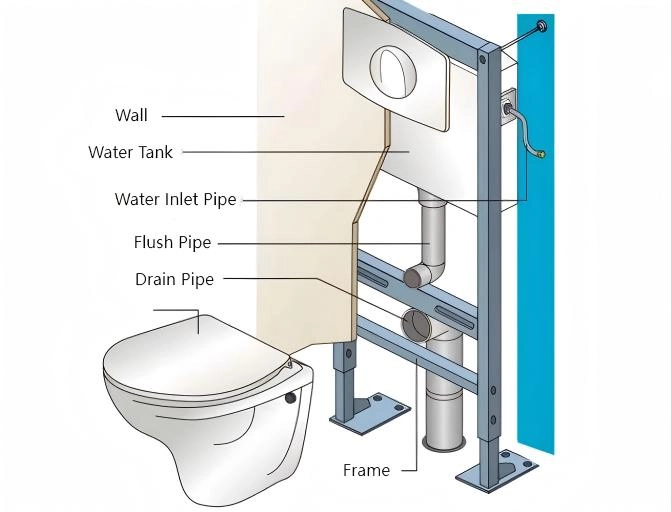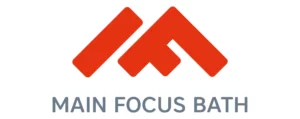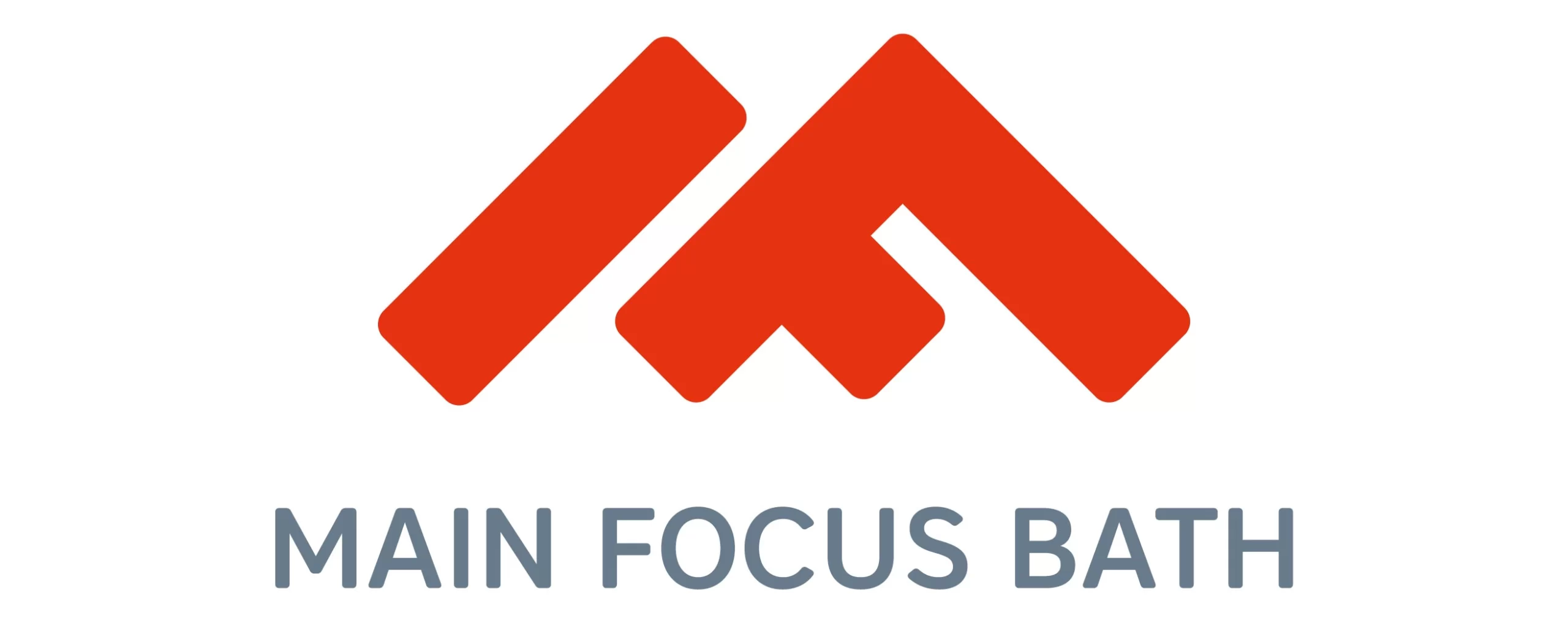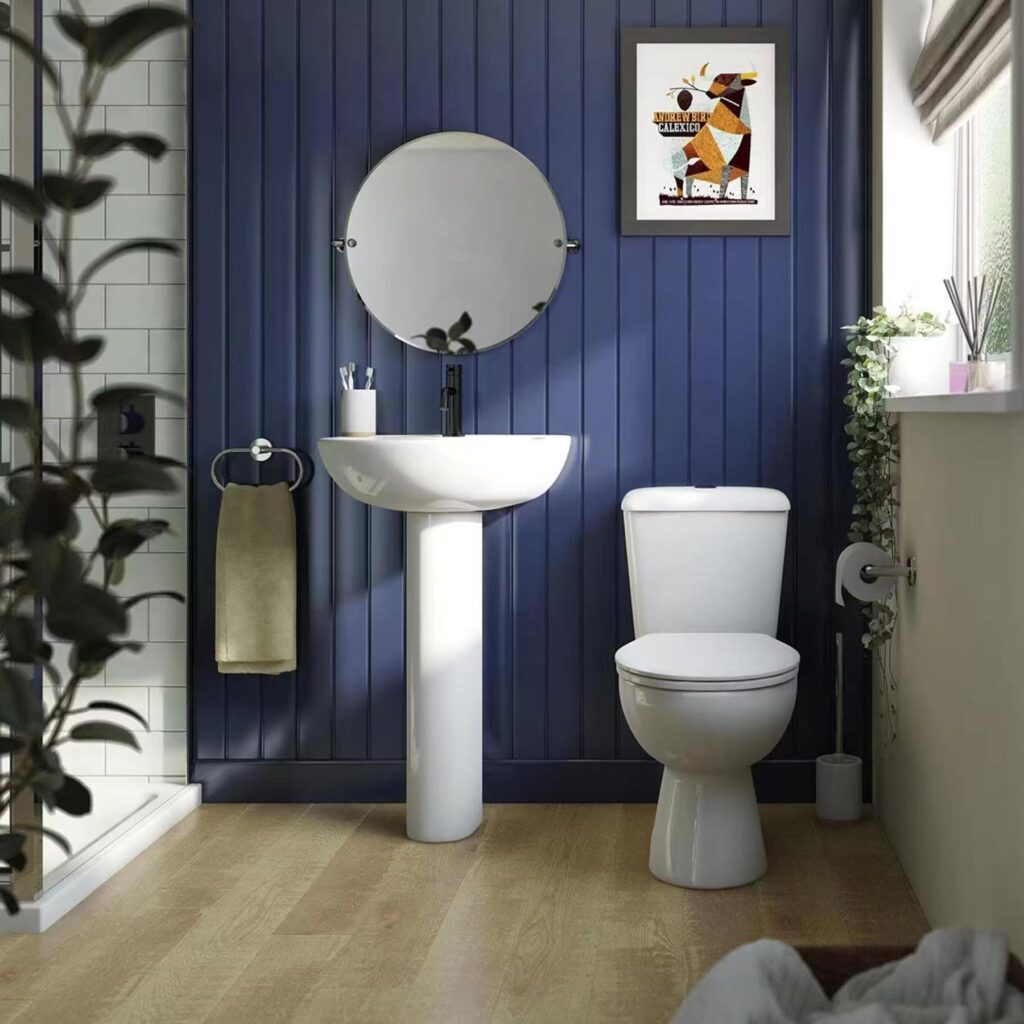מָבוֹא
Navigating the maze of commercial toilet regulations can be a costly minefield for architects, contractors, and facility managers. One misstep in compliance can lead to project delays, hefty fines, or even legal battles that drain resources and damage reputations.
Wall-hung toilets, while space-saving and aesthetically pleasing, come with their own set of complex regulatory challenges. From varying building codes to stringent ADA requirements, ensuring these fixtures meet all necessary standards is far from straightforward. This guide cuts through the confusion, offering a clear roadmap to compliance for commercial wall-hung toilet installations.
Whether you’re tackling a new build or retrofitting an existing space, understanding these regulations is “mission-critical”. We’ll explore everything from plumbing codes and workplace sanitation rules to international variations in standards. By mastering these essentials, you’ll not only avoid compliance pitfalls but also streamline your projects and build trust with clients who rely on your expertise to navigate this complex landscape.
Introduction to Commercial Toilet Regulations
When it comes to outfitting commercial spaces with restroom facilities, understanding and adhering to commercial toilet regulations is crucial. As a business owner or facility manager, you’re not just picking out fixtures – you’re navigating a complex web of rules that ensure safety, accessibility, and compliance. Let’s dive into the world of commercial toilet regulations, with a special focus on wall-hung toilets, and explore why getting it right is so important for your business.
“Commercial toilet regulations are essential guidelines that ensure public restrooms meet safety, hygiene, and accessibility standards, protecting both businesses and their patrons.”
Why Compliance Matters in Commercial Construction
Compliance with commercial toilet regulations isn’t just about following rules – it’s about protecting your investment and your customers. Failing to meet these standards can result in hefty fines, costly renovations, and even legal trouble. But more than that, proper compliance creates a safe, accessible environment that shows you care about your customers’ needs. It’s not just “good business” – it’s the right thing to do.
Overview of Wall-Hung Toilets: Benefits and Challenges
Wall-hung toilets are becoming increasingly popular in commercial settings, and for good reason. They offer a sleek, modern look while saving valuable floor space. Cleaning is easier, and they can be installed at various heights to accommodate different needs. However, they also present unique challenges when it comes to meeting toilet requirements for businesses. Proper installation is crucial, and weight limits must be carefully considered to ensure safety and longevity.
Key Regulatory Bodies: OSHA, ADA, and Beyond
When it comes to commercial restroom standards, several regulatory bodies come into play. The Occupational Safety and Health Administration (OSHA) sets guidelines for workplace safety, including restroom facilities. The Americans with Disabilities Act (ADA) ensures that public restrooms are accessible to all. But these aren’t the only players – local building codes, health department regulations, and industry-specific standards may also apply. Navigating this regulatory landscape can be complex, but it’s essential for compliance.
Common Compliance Pitfalls and Their Costs
Failing to meet commercial toilet regulations can be costly in more ways than one. Common pitfalls include improper toilet height, inadequate clear floor space, and insufficient support for wall-hung units. These issues can lead to fines, forced closures for renovations, and even lawsuits. By partnering with trusted suppliers like MFBath, you can ensure that your fixtures are pre-vetted for compliance, saving you time, money, and headaches down the road.
| Compliance Issue | Potential Fine | Renovation Cost | Business Disruption | Legal Risk |
|---|---|---|---|---|
| Improper Toilet Height | $1,000 – $5,000 | $500 – $2,000 per unit | 1-3 days | בֵּינוֹנִי |
| Inadequate Clear Floor Space | $5,000 – $15,000 | $5,000 – $20,000 | 1-2 weeks | גָבוֹהַ |
| Insufficient Wall Support | $2,000 – $10,000 | $1,000 – $5,000 per unit | 3-7 days | גָבוֹהַ |
| Non-ADA Compliant Fixtures | $10,000 – $50,000 | $10,000 – $30,000 | 2-4 weeks | גבוה מאוד |
| Improper Signage | $500 – $2,500 | $100 – $500 | 1 day | נָמוּך |
Understanding what are the regulations for commercial toilets is just the first step. Implementing them correctly requires expertise and attention to detail. At MFBath, we’re committed to helping businesses navigate these challenges with our range of compliant, high-quality sanitary ware solutions. By choosing the right partner, you can ensure that your commercial restrooms not only meet regulatory standards but also provide a comfortable, accessible experience for all users.

Mastering Wall-Hung Toilet Building Codes
When it comes to installing wall-hung toilets in commercial settings, understanding and adhering to building codes is crucial. These regulations ensure that your restroom facilities are not only functional and efficient but also safe and accessible for all users. Let’s dive into the key aspects of commercial toilet regulations, focusing on wall-hung toilets and how to meet building regulations for these innovative fixtures.
“Wall-hung toilet building codes are critical for ensuring structural integrity, accessibility, and efficiency in commercial restrooms, balancing safety with modern design.”
Installation Heights and Structural Support Standards
One of the most critical aspects of installing wall-hung toilets is ensuring proper height and structural support. Building codes for toilet installation typically require that the rim of the toilet bowl be between 17 to 19 inches from the finished floor for adult use. However, accessibility standards may require some toilets to be installed at different heights. The structural support must be capable of withstanding significant weight – usually at least 500 pounds of force.
Flush Valve Requirements for Efficiency and Durability
Plumbing codes for commercial toilets often specify requirements for flush valves to ensure water efficiency and durability. Most codes now require low-flow fixtures, typically 1.6 gallons per flush or less. The flush valve must also be designed to withstand the high usage typical in commercial settings. This is where choosing quality fixtures, like those offered by MFBath, can make a significant difference in long-term performance and compliance.
Local vs. National Building Code Variations
While there are national standards like the Uniform Plumbing Code (UPC) and International Plumbing Code (IPC), it’s crucial to remember that local jurisdictions may have their own variations. These local codes can affect everything from water pressure requirements to specific installation procedures. Always check with local authorities to ensure you’re meeting all applicable standards.
| Code Aspect | UPC Standard | IPC Standard | Common Local Variations | MFBath Compliance |
|---|---|---|---|---|
| Toilet Height (Adult) | 17-19 inches | 17-19 inches | 15-19 inches | Adjustable 15-19 inches |
| Weight Support | 500 lbs | 500 lbs | 300-750 lbs | Up to 750 lbs |
| Water Usage | 1.6 GPF max | 1.6 GPF max | 1.28-1.6 GPF | 1.28 GPF standard |
| ADA Compliance | Required | Required | Always Required | Fully Compliant Models |
| Flush Valve Durability | 250,000 cycles | 250,000 cycles | 200,000-300,000 cycles | 300,000+ cycles |
Retrofitting Challenges in Existing Commercial Spaces
Retrofitting existing spaces with wall-hung toilets can present unique challenges. The building’s existing plumbing and wall structure may need significant modifications to accommodate these fixtures. This is where commercial toilet regulations intersect with broader building codes, potentially requiring updates to wall reinforcement, plumbing rough-ins, and even electrical systems if you’re installing more advanced models.
At MFBath, we understand these challenges and design our wall-hung toilets to simplify compliance across various code requirements. Our fixtures are engineered to meet or exceed U.S. and international standards, making them an ideal choice for large-scale commercial projects. By choosing MFBath, you’re not just getting a toilet – you’re getting a solution that’s been “vetted and approved” to meet rigorous building codes.
Mastering wall-hung toilet building codes is essential for any commercial construction or renovation project. By understanding these regulations and choosing compliant, high-quality fixtures, you can ensure your restroom facilities are safe, efficient, and built to last. Remember, while this guide provides a solid overview, always consult with local authorities and licensed professionals to ensure full compliance with all applicable codes and standards.

Ensuring Accessibility with ADA Compliance
When it comes to commercial toilet regulations, ADA compliance is not just a legal requirement – it’s a commitment to inclusivity and accessibility for all. As facility managers and business owners, understanding and implementing ADA standards for wall-hung toilets is crucial for creating welcoming, accessible spaces. Let’s dive into the key aspects of ADA compliance and how it shapes commercial restroom standards.
“ADA compliance in commercial restrooms ensures equal access for all individuals, promoting inclusivity while meeting legal requirements and reducing liability risks.”
ADA Mounting Height and Clear Floor Space Guidelines
ADA compliance for toilets starts with proper mounting height and clear floor space. Wall-hung toilets must be installed with the rim 17-19 inches from the finished floor. This height range ensures accessibility for most users, including those with mobility challenges. Additionally, a clear floor space of at least 60 inches by 56 inches must be maintained around the toilet, allowing for easy maneuvering of wheelchairs.
Grab Bar and Fixture Placement Requirements
Proper placement of grab bars is essential for ADA compliance. Side walls must have a grab bar at least 42 inches long, positioned no more than 12 inches from the back wall. The rear wall requires a grab bar at least 36 inches long. These specifications ensure users can safely transfer to and from the toilet. Other fixtures, such as toilet paper dispensers, must be within easy reach, typically 7-9 inches in front of the toilet seat.
Common ADA Compliance Mistakes to Avoid
Even with the best intentions, mistakes in ADA compliance can occur. Common errors include improper toilet height, insufficient clear floor space, and incorrectly placed grab bars. Another frequent oversight is failing to account for the protrusion of wall-hung toilets when measuring clear space. By partnering with experienced manufacturers like MFBath, you can avoid these pitfalls and ensure your restrooms meet all ADA requirements.
| ADA Requirement | Specification | Common Mistake | MFBath Solution | Compliance Impact |
|---|---|---|---|---|
| Toilet Height | 17-19 inches | Too high/low installation | Adjustable mounting system | גָבוֹהַ |
| Clear Floor Space | 60″ x 56″ minimum | Obstructions in clear space | Space-saving design | Critical |
| Side Grab Bar | 42″ long, max 12″ from back wall | Incorrect placement | Pre-marked installation guides | גָבוֹהַ |
| Rear Grab Bar | 36″ long minimum | Insufficient length | Compliant grab bar kits | גָבוֹהַ |
| Fixture Reach Range | 7-9″ from toilet seat | Out of reach placement | Integrated accessory options | בֵּינוֹנִי |
Benefits of Accessibility Beyond Legal Mandates
While meeting ADA requirements is legally necessary, the benefits extend far beyond compliance. Accessible restrooms create a more inclusive environment, enhancing customer satisfaction and loyalty. They also future-proof your facility, accommodating an aging population and reducing the need for costly renovations down the line. By prioritizing accessibility, you’re not just following the law – you’re “stepping up” to meet the needs of all potential users.
Implementing a commercial restroom compliance checklist can help ensure all aspects of ADA regulations are met. This should include verifying toilet heights, clear floor spaces, grab bar placements, and fixture accessibility. Regular audits using this checklist can prevent compliance issues before they become costly problems.
At MFBath, we understand the importance of ADA compliance in commercial settings. Our range of ADA-compliant wall-hung toilets are designed to meet all necessary standards while offering stylish, efficient solutions for modern restrooms. By choosing MFBath products, facility managers can reduce liability risks and enhance the overall appeal of their public spaces, ensuring accessibility for all users.

Plumbing Codes and Installation Best Practices
When it comes to installing wall-hung toilets in commercial settings, understanding and adhering to plumbing codes is crucial. These regulations ensure that your restroom facilities are not only functional and efficient but also safe and compliant with local and national standards. Let’s dive into the key aspects of plumbing codes for commercial toilets and explore best practices for installation.
“Proper adherence to plumbing codes and installation best practices for wall-hung toilets ensures efficiency, safety, and compliance in commercial restrooms.”
Pipe Sizing and Water Efficiency Standards
One of the primary considerations in commercial toilet regulations is proper pipe sizing and water efficiency. The EPA WaterSense program sets stringent standards for water conservation, requiring toilets to use no more than 1.28 gallons per flush while still providing adequate waste removal. Proper pipe sizing is crucial to ensure efficient water flow and prevent clogs in high-traffic environments.
Waste Management and Ventilation Requirements
Effective waste management and proper ventilation are essential for maintaining a hygienic and odor-free restroom environment. Plumbing codes typically specify minimum pipe diameters for waste lines and required vent pipe sizes. These requirements help prevent sewer gas from entering the building and ensure proper waste removal, which is particularly important in commercial settings with high usage.
Coordinating with Local Plumbing Codes
While national standards provide a framework, it’s crucial to coordinate with local plumbing codes when installing wall-hung toilets. Local regulations may have specific requirements for fixture placement, water pressure, or even the types of materials used in plumbing systems. Always consult with local authorities or licensed plumbers familiar with regional codes to ensure full compliance.
| Plumbing Aspect | National Standard | Common Local Variations | MFBath Compliance | Installation Impact |
|---|---|---|---|---|
| Water Usage | 1.28 GPF (WaterSense) | 1.0-1.6 GPF | Adjustable 1.0-1.6 GPF | גָבוֹהַ |
| Waste Pipe Diameter | 3 inches minimum | 3-4 inches | Compatible with 3-4 inch systems | Critical |
| Vent Pipe Size | 1.5 inches minimum | 1.5-2 inches | Adaptable to various vent sizes | בֵּינוֹנִי |
| Water Pressure | 20-80 PSI | 30-60 PSI typical | Optimal performance 30-60 PSI | גָבוֹהַ |
| ADA Compliance | Required for public spaces | Always required | Fully ADA compliant options | Critical |
Installation Tips for High-Traffic Environments
Installing wall-hung toilets in high-traffic commercial environments presents unique challenges. Here are some key tips to ensure a successful installation:
- Use heavy-duty mounting hardware to support the increased weight and usage.
- Consider installing accessible models to meet toilet requirements for businesses and ADA standards.
- Implement water-saving features to reduce long-term costs and meet efficiency standards.
- Ensure proper sealing around wall connections to prevent leaks and water damage.
- Plan for easy access panels for maintenance and repairs.
To streamline the installation process and ensure compliance, many contractors choose pre-certified products from reputable suppliers like MFBath. These products are designed to meet or exceed national and local standards, reducing installation time and potential compliance issues. By choosing “ready-to-go” solutions, you can significantly cut down on project timelines and costs.
Understanding how to meet building regulations for wall-hung toilets is crucial for any commercial construction or renovation project. By adhering to plumbing codes and following installation best practices, you can ensure that your commercial restrooms are efficient, compliant, and built to withstand the demands of high-traffic environments. Remember, while this guide provides valuable insights, always consult with licensed professionals and local authorities to ensure full compliance with all applicable codes and standards.

Navigating Global Compliance and Bulk Supply Solutions
In today’s interconnected world, understanding commercial toilet regulations on a global scale is crucial for businesses operating across borders. Whether you’re managing a multinational corporation or sourcing supplies for large-scale projects, navigating the complexities of international standards and procurement strategies is essential. Let’s explore how to ensure compliance while efficiently sourcing wall-hung toilets for commercial spaces worldwide.
“Global compliance in commercial toilet regulations requires a nuanced understanding of regional standards and a strategic approach to bulk procurement, ensuring safety and efficiency across diverse markets.”
U.S. vs. European Standards: UPC vs. CE Certification
One of the primary challenges in global compliance is understanding the differences between U.S. and European standards. In the U.S., the Uniform Plumbing Code (UPC) sets the benchmark for commercial restroom standards. In contrast, European markets rely on CE certification, which ensures products meet EU safety, health, and environmental requirements. Navigating these differences is crucial when sourcing wall-hung toilets for international projects.
Adapting to Regional Health and Safety Regulations
Beyond plumbing codes, workplace sanitation regulations can vary significantly across regions. What meets standards in one country may fall short in another. For instance, water efficiency requirements, accessibility standards, and even toilet design preferences can differ. Staying informed about these regional variations is crucial for maintaining compliance and user satisfaction in diverse markets.
Sourcing Certified Wall-Hung Toilets for Large Projects
When it comes to large-scale commercial projects, sourcing certified wall-hung toilets in bulk presents unique challenges. It’s not just about finding a supplier with the capacity to fulfill large orders; it’s about ensuring each unit meets the specific commercial toilet regulations of the target market. This is where partnering with globally-minded manufacturers becomes invaluable.
| הסמכה | Region | Key Requirements | MFBath Compliance | Global Project Impact |
|---|---|---|---|---|
| UPC (USA) | צפון אמריקה | Water efficiency, structural integrity | Fully compliant models available | High for US projects |
| CE (Europe) | European Union | Safety, health, environmental protection | CE certified product range | Critical for EU market access |
| ADA (USA) | Global (recognized) | Accessibility standards | ADA compliant options | Essential for inclusive design |
| ISO 9001 | גלוֹבָּלִי | Quality management systems | ISO 9001 certified manufacturing | Enhances global credibility |
| Local Certifications | Various | Region-specific requirements | Adaptable to local standards | Crucial for market-specific projects |
Benefits of Partnering with Manufacturers like MFBath
Choosing the right manufacturing partner can significantly simplify the process of meeting global commercial toilet regulations. MFBath, for instance, offers CE-certified wall-hung toilets that comply with European standards while also providing options that meet UPC requirements. This dual compliance ensures that businesses can “kill two birds with one stone”, sourcing products that are viable across multiple markets.
Furthermore, partnering with a manufacturer like MFBath brings additional benefits:
- Consistent quality across large orders, ensuring each unit meets stringent standards
- Expertise in navigating international shipping and customs regulations
- Ability to provide documentation and certifications required for different markets
- Flexibility to adapt products to specific regional requirements
- Ongoing support and guidance on evolving regulations and standards
Understanding what are the regulations for commercial toilets in various global markets is just the first step. The real challenge lies in efficiently sourcing compliant products at scale. By partnering with manufacturers that prioritize global compliance and offer versatile product lines, businesses can streamline their procurement process and ensure they meet commercial restroom standards worldwide.
In conclusion, navigating global compliance for wall-hung toilets requires a strategic approach to sourcing and a deep understanding of diverse regulatory landscapes. By leveraging partnerships with manufacturers like MFBath, businesses can confidently tackle international projects, knowing they have a reliable source for compliant, high-quality commercial toilet solutions.

מַסְקָנָה
After diving deep into the world of commercial toilet regulations, it’s clear that compliance isn’t just about ticking boxes – it’s about creating spaces that work for everyone. From my years in the industry, I’ve seen firsthand how the right fixtures can make or break a project.
Wall-hung toilets aren’t just a modern design choice; they’re a smart solution for meeting the complex web of codes we’ve explored. Whether you’re dealing with ADA requirements, plumbing standards, or international certifications, the key is partnering with manufacturers who understand these challenges inside and out.
At MFBath, we’re committed to being that partner, offering solutions that are “ready to roll” for projects of any scale, anywhere in the world. Remember, investing in compliance isn’t just about avoiding fines – it’s about building spaces that are truly accessible, efficient, and built to last.
שאלות נפוצות
-
Q1: What are the regulations for commercial toilets?
A1: Commercial toilet regulations vary by location but generally require compliance with local building codes, health codes, and the Americans with Disabilities Act (ADA). Common standards include the number of toilets based on occupancy, accessibility features, and sanitation guidelines.
-
Q2: How many toilets are required in a commercial building?
A2: The number of required toilets in a commercial building is determined by the number of employees and the building’s capacity. For example, businesses with up to 15 employees must provide at least one unisex restroom, while those with more employees must offer additional facilities.
-
Q3: What is the ADA compliance for toilets?
A3: ADA compliance for toilets mandates specific design features to ensure accessibility for individuals with disabilities. This includes requirements for grab bars, toilet height, and accessible pathways, ensuring that all users can access the facilities comfortably.
-
Q4: What are the toilet requirements for businesses under OSHA?
A4: Under OSHA regulations, employers must provide sanitary and immediately available toilet facilities for their employees. The exact requirements vary based on the number of employees and the nature of the work environment.
-
Q5: Are there specific plumbing codes for commercial toilets?
A5: Yes, plumbing codes for commercial toilets outline requirements for installation, maintenance, and functionality of restroom facilities. These codes include specifications for water supply, drainage, and waste removal to ensure health and safety.
-
Q6: What is included in a commercial restroom compliance checklist?
A6: A commercial restroom compliance checklist typically includes items such as ADA accessibility, sufficient parking for restrooms, maintenance of sanitary conditions, proper signage, and compliance with local health and safety regulations.
-
Q7: How to meet building regulations for wall-hung toilets?
A7: To meet building regulations for wall-hung toilets, ensure that you follow the local building codes, which may include weight capacity limits, installation height, and plumbing requirements. Consulting a licensed plumber can help ensure compliance.
-
Q8: What sanitation regulations apply to commercial restrooms?
A8: Sanitation regulations for commercial restrooms typically require that facilities maintain a clean and sanitary environment. This includes regular cleaning and maintenance, adequate supplies of toilet paper and soap, and proper waste disposal.
קישורים חיצוניים
- Regulations on Toilet Requirements – Concept Cubicle Systems
- Commercial Bathroom Code Requirements | VPC Builders
- Public Restroom Rules & Regulations | One Point Partitions
- Toilet Requirements in Commercial Buildings – Bizfluent
- OSHA Regulations on Restrooms for General Industry
- Restrooms and Sanitation Requirements – Overview | OSHA
- Commercial Toilets – US EPA
- Toilet accommodation: Approved Document T – GOV.UK





